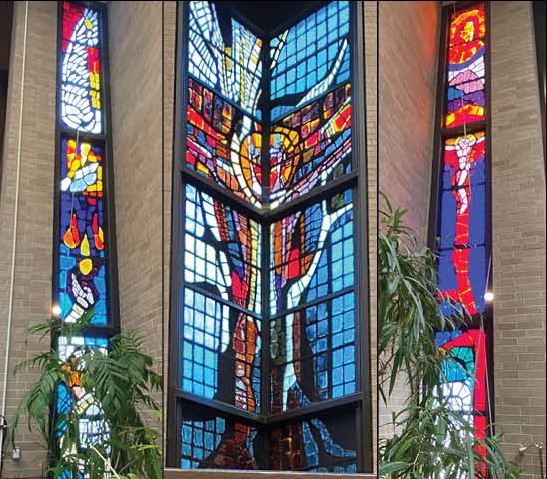Progress & Reverence
Posted: 06/06/2024
Since my arrival on July 1, many of you have asked how my transition to St. Alphonsus is going. While the first two weeks seemed to be somewhat rough on several fronts, I have enjoyed meeting new people and listening to your ideas, suggestions, and vision for the future. I definitely sense the Holy Spirit saying things to me through repeated comments and suggestions. That is one of the reasons that I wanted several listening sessions, instead of just one or two of them. I can also sense some of your excitement and anticipation of what may be some of the first changes that you expect me to make around St. Alphonsus. Well, if hiring a new principal and a new school facilities manager and two new organists, changing out lighting, having listening sessions, visiting with many of the different groups that meet on campus, and presenting some ideas to the diocesan Liturgy, Art and Music Board (LAMB) is not enough change from you in the first month, then just you wait… Certain other changes will be coming, but more slowly.
One of the first things that I will address in the coming months is a greater sense of reverence for the Eucharist in church and during the Mass. I am not saying that we are totally irreverent, but I am saying that the Gospel readings for the next few weeks from John 6–the Bread of Life discourse—will set the tone for this discussion and some modifications to the church sanctuary. I am working with Bishop Duca and LAMB, as well as some interested parishioners/donors, woodworkers and contractors/builders to make these changes, which will affect the placement of the baptismal font, the presiders' chairs, and the tabernacle. Bishop Duca and LAMB have approved two of the three proposed changes.

I also think that part of reverence comes with knowledge, which brings me to a little bit of education this week. Since learning about my assignment at St. Alphonsus, I have sought out the answer to a burning question in my mind: What is the significance of the stained glass window in the middle of the sanctuary? I was surprised to get many different answers but nothing definitive. I even called the diocesan archives office to see if any information could be found from the church construction documents in 1978. So I wonder if any of you have ever pondered that question as well… And I’m happy to give you some answers today.
Milton Pounds of Slidell, a student of Paul Dufour in Baton Rouge, designed and manufactured these windows in the French “dalle de verre” style. I say windows because there are two additional windows (hidden from the congregation’s view) that complete the story of the center window. These three windows together represent the Holy Trinity. Basically, it is like having a contemporary Russian icon triptych, just made out of stained glass panels.
The center window (that everyone sees) is an abstract vision of God the Father creating the world and particularly Adam out of earth at the base of the window.
When you are looking at the sanctuary, the window in the right corner is dedicated to Jesus the Son, with the top part of the window demonstrating the incarnation and light breaking through the darkness. The middle pane shows Jesus on the cross as the “new Adam,” whose blood pouring down and redeeming Adam at the base of the window. Adam is in the tomb, shrouded in white burial cloth. This is significant to the Redemptorist history of St. Alphonsus. The Redemptorists always wore a crucifix that portrayed Adam’s skull and bones under the sacrifice of Christ. It is a long-standing tradition of the Church that Adam was buried on Mount Moriah (for us, Golgotha or Calvary), under the same location where Jesus died on the cross. Today in the Church of the Holy Sepulcher in Jerusalem, one can descend to the cave of Adam and see a fissure in the rock (created by the earthquake mentioned in the Gospel) at the time of Jesus' death, where the blood of Christ poured over the tomb of Adam. The second window portrays this redemptive action of Jesus.
And finally, on the left side of the sanctuary, we have the third window dedicated to God the Holy Spirit. The Holy Spirit is in the form of a dove at the top of the window, And there are tongues of fire descending upon an apostle at the base of the window, who is looking upwards with his hand raised to receive the grace of the Holy Spirit. This is God sanctifying humanity and calling the Church to action and evangelization. And considering the time period of 1978 when St. Alphonsus Church was built and dedicated, there was a lot of theological emphasis and writing on God being creator, redeemer, and sanctifier. There was so much discussion on the roles of God that clergy were even baptizing people using these titles/attributes, instead of “in the name of the Father, and of the Son, and of the Holy Spirit.” The Church had to clarify later that these baptisms were invalid; and the clergy, religious and laity needed to refer to God as revealed in the Bible by Jesus, instead of limiting God the Father as the “creator,” Jesus the Son as the “redeemer,” and the God the Holy Spirit as the “sanctifier.” The reason being that all three persons create, all three redeem, and all three sanctify. God is one, yet distinct as three persons, but God is perfect Communion and Will. All create together, redeem together, and sanctify together. So when you look at those three windows, I hope it all makes a little more sense to you now, and this knowledge will help facilitate a deeper sense of prayer and reverence when you are in the church.
In Christ,
Fr. Jason
Author:
Rev. Jason Palermo
Back to News


 Close
Close
